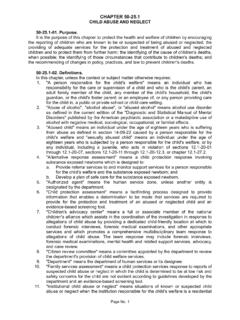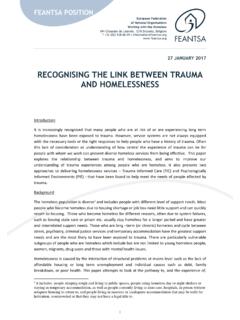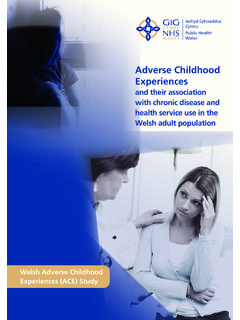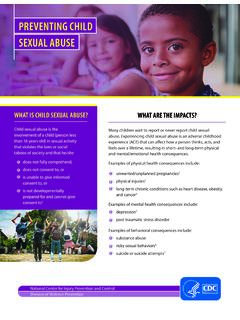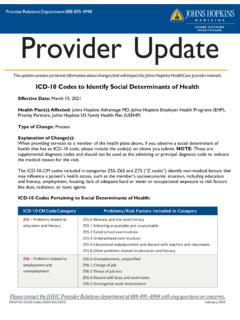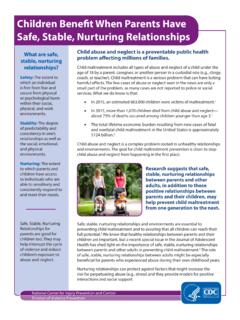Transcription of Children's Exposure to Violence: A Comprehensive National ...
1 Department of JusticeOffice of Justice ProgramsOffice of Juvenile Justice and Delinquency Prevention Access OJJDP publications online at s Exposure to ViolenceNATIONAL SURVEY OFChildren s Exposure to ViolenceOffice of Justice ProgramsInnovation Partnerships Safer Neighborhoods Slowikowski, Acting Administrator October 2009 Access OJJDP publications online at Message From OJJDPC hildren are exposed to violence every day in their homes, schools, and communities. They may be struck by a boyfriend, bullied by a classmate, or abused by an adult. They may witness an assault on a parent or a shooting on the street. Such Exposure can cause significant physical, mental, and emotional harm with long-term effects that can last well into 1999, OJJDP created the Safe Start Initiative to prevent and reduce the impact of children s Exposure to violence through enhanced practice, research, evaluation, training and technical assistance, resources, and outreach.
2 The initiative has improved the delivery of developmentally appro-priate services for children exposed to violence and their the nature and extent of children s Exposure to violence is essential to combating its effects. Partnering with the Centers for Dis-ease Control and Prevention, OJJDP has sponsored the most compre-hensive effort to date to measure children s Exposure to violence . The National Survey of children s Expo-sure to violence is the first survey to ask children and caregivers about Exposure to a range of violent inci-dents and amply evidenced in this Bulletin, children s Exposure to violence is pervasive and crosses all ages. The research findings reported here are critical to informing our efforts to pro-tect children from its damaging OJJDP publications online at s Exposure to violence : A Comprehensive National SurveyDavid Finkelhor, Heather Turner, Richard Ormrod, Sherry Hamby, and Kristen KrackeThis Bulletin discusses the National Sur-vey of children s Exposure to violence (NatSCEV), the most Comprehensive nationwide survey of the incidence and prevalence of children s Exposure to vio-lence to date, sponsored by the Office of Juvenile Justice and Delinquency Preven-tion (OJJDP) and supported by the Cen-ters for Disease Control and Prevention (CDC).
3 Conducted between January and May 2008, it measured the past-year and lifetime Exposure to violence for children age 17 and younger across several major categories: conventional crime, child maltreatment, victimization by peers and siblings, sexual victimization, witnessing and indirect victimization (including expo-sure to community violence and family violence ), school violence and threats, and Internet victimization. (For more detailed information on the types of violence that children were questioned about, see Screening Questions on page 2.) This survey is the first Comprehensive attempt to measure children s Exposure to vio-lence in the home, school, and community across all age groups from birth to age 17, and the first attempt to measure the cumu-lative Exposure to violence over the child s survey confirms that most of our society s children are exposed to violence in their daily lives. More than 60 percent of the children surveyed were exposed to violence within the past year, either directly or indirectly ( , as a witness to a violent act; by learning of a violent act against a family member, neighbor, or close friend; or from a threat against their home or school) (for full details on these and other statistics cited in this Bulletin, see Finkelhor et al.)
4 , 2009). Nearly one-half of the children and adolescents surveyed ( percent) were assaulted at least once in the past year, and more than 1 in 10 ( percent) were injured in an assault; 1 in 4 ( percent) were victims of robbery, vandalism, or theft; 1 in 10 ( percent) suffered from child maltreatment (includ-ing physical and emotional abuse, neglect , or a family abduction); and 1 in 16 ( per-cent) were victimized sexually. More than 1 in 4 ( percent) witnessed a violent act 2and nearly 1 in 10 ( percent) saw one family member assault another. Multiple victimizations were common: more than one-third ( percent) experienced 2 or more direct victimizations in the previ-ous year, more than 1 in 10 ( percent) experienced 5 or more direct victimiza-tions in the previous year, and more than 1 in 75 ( percent) experienced 10 or more direct victimizations in the previous year. Reports of lifetime Exposure to violence were generally about one-third to one-half higher than reports of past-year Exposure , although the difference tended to be greater for less frequent and more severe types of victimization.
5 (For example, more than three times as many respondents reported being victims of a kidnapping over their lifetimes as did in the past year.) Nearly seven in eight children ( percent) who reported being exposed to violence during their lifetimes also reported being exposed to violence within the past year, which indicated that these children were at ongoing risk of violent victimization. The reports of lifetime Exposure also indicate how certain types of Exposure change and accumulate as a child grows up; nearly one in five girls ages 14 to 17 ( percent) had been the victim of a sexual assault or attempted sexual assault, and more than one-third of all 14- to 17-year-olds had seen a parent assaulted. BackgroundThe Problem of violence Against ChildrenChildren in the United States are more likely to be exposed to violence and crime than are adults (Finkelhor, 2008; Hashima and Finkelhor, 1999). In 2005, juveniles and young adults ages 12 to 19 were more than twice as likely to be victims of vio-lent crimes as the population as a whole (Baum, 2005).
6 1 Each year, millions of chil-dren and adolescents in the United States are exposed to violence in their homes, schools, and communities as both victims and witnesses. Even if they are not physi-cally present, children may be affected by intentional harm done by another (for example, the murder of or an assault on a family member or close neighbor). children react to Exposure to violence in different ways, and many children show remarkable resilience. All too often, however, children who are exposed to violence undergo lasting physical, mental, and emotional harm. They suffer from difficulties with attachment, regressive behavior, anxiety and depression, and aggression and conduct problems. They may be more prone to dating violence , delinquency, further victimization, and involvement with the child welfare and juvenile justice systems. Moreover, being exposed to violence may impair a child s capacity for partnering and parenting later in life, continuing the cycle of violence into the next has found that early identifica-tion, intervention, and continued followup are valuable strategies to prevent or decrease the impact of Exposure to vio-lence.
7 Families, teachers, police, judges, pediatricians, mental health providers, child protection workers, domestic vio-lence advocates, and others who interact with children have a responsibility to create interventions, both physical and psychological, that decrease or prevent the harms associated with Exposure to These include ways of interact-ing sensitively and expeditiously with Screening QuestionsThe survey asked screening questions about 48 types of victimization in the fol-lowing categories:u Conventional crime. Nine types of victimization, including robbery, theft, destruction of property, attack with an object or weapon, attack without an object or weapon, attempted attack, threatened attack, kidnapping or attempted kidnapping, and hate crime or bias attack (an attack on a child because of the child s or parent s skin color, religion, physi-cal problem, or perceived sexual orientation).u Child maltreatment. Four types of victimization, including being hit, kicked, or beaten by an adult (other than spanking on the bottom); psychological or emotional abuse; neglect ; and abduction by a parent or caregiver, also known as custodial Peer and sibling victimization.
8 Six types of victimization, including being attacked by a group of children ; being hit or beaten by another child, including a brother or sister; being hit or kicked in the private parts; being chased, grabbed, or forced to do some-thing; being teased or emotionally bullied; and being a victim of dating Sexual victimization. Seven types of victimization, including sexual contact or fondling by an adult the child knew, sexual contact or fondling by an adult stranger, sexual contact or fondling by another child or teenager, attempted or completed intercourse, Exposure or flashing, sexual harassment, and consensual sexual conduct with an Witnessing and indirect victimization. These fall into two general categories, expo-sure to community violence and Exposure to family violence . For Exposure to commu-nity violence , the survey included 10 types of victimization, including seeing someone attacked with an object or weapon; seeing someone attacked without an object or weapon; having something stolen from the household ; having a friend, neighbor, or fam-ily member murdered; witnessing a murder; witnessing or hearing a shooting, bombing, or riot; being in a war zone; knowing a family member or close friend who was fondled or forced to have sex; knowing a family member or close friend who was robbed or mugged; and knowing a family member or close friend who was threatened with a gun or knife.
9 For Exposure to family violence , eight types of victimization were assessed: seeing a parent assaulted by a spouse, domestic partner, or boyfriend or girlfriend; seeing a brother or sister assaulted by a parent; threat by one parent to assault the other; threat by a parent to damage the other parent s property; one parent pushing the other; one parent hitting or slapping the other; one parent kicking, choking, or beating up the other; and assault by another adult household member against a child or adult in the School violence and threat. Two types of victimization, including a credible bomb threat against the child s school and fire or other property damage to the Internet violence and victimization. Two types of victimization, including Internet threats or harassment and unwanted online sexual solicitation. 3children, ensuring protective environ-ments and caregivers, and helping chil-dren use positive coping skills.
10 Much more research is warranted about what works to mitigate the effects of Exposure to little is known about the numbers of children exposed to violence . Although several studies have attempted to mea-sure children s Exposure to violence , these estimates have varied greatly and have often measured only a subset of that Not only does this partial measurement fail to reveal the full extent of violence against children , it also fails to account fully for the multiple victimiza-tions that many children experience; the co-occurrence of certain types of violence (for example, intimate partner violence and child maltreatment or neglect within a household ); the extent to which Exposure to one type of violence may make a child more vulnerable to other types of violence and victimization; and the cumulative effects of repeated Exposure to violence as both a direct victim and a witness. Basic epidemiological data are important to determine the extent of the public health problem, the need for services, and a baseline for evaluating Attempts at Comprehensive MeasurementsThere have been many studies on the health and behavioral consequences of child maltreatment and, to a lesser extent, on other forms of violence against However, most of these studies focused on only one type of violence or on a few types within a single category such as child Two notable earlier studies attempted to measure children s Exposure to violence and its adverse effects in a more Comprehensive fash-ion.










